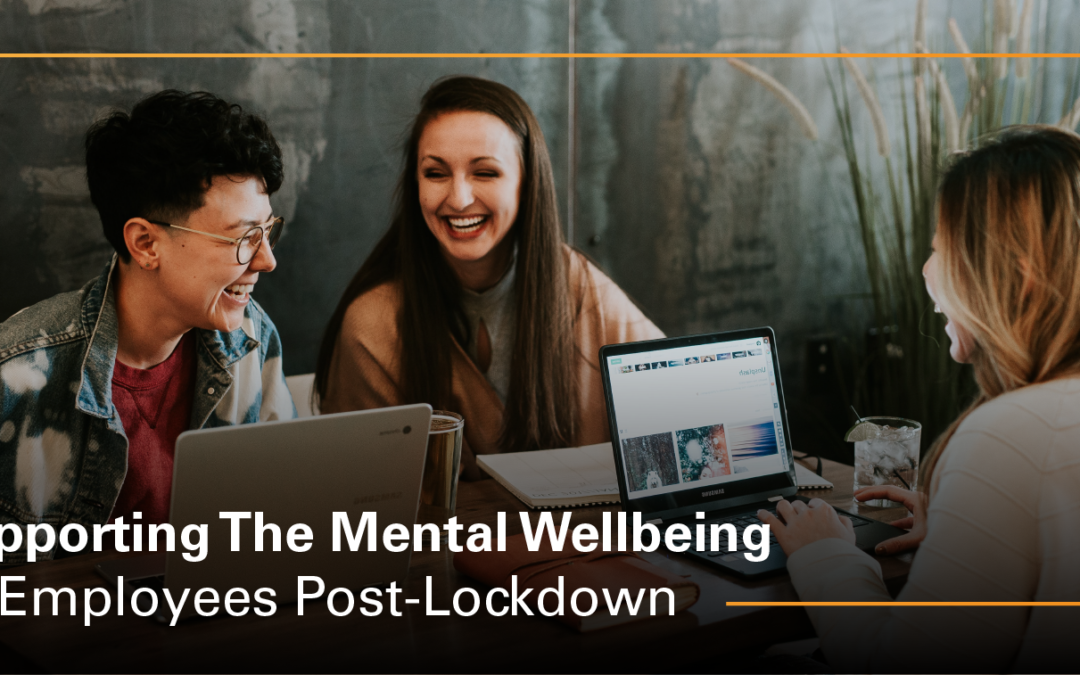SUPPORTING THE MENTAL WELLBEING OF EMPLOYEES POST-LOCKDOWN
The COVID-19 pandemic has had a major impact on people’s mental wellbeing. It has particularly affected frontline workers, students, people living alone, and those with pre-existing mental health conditions.
According to the Australian Bureau of Statistics, in June this year, one in five Australians experienced high or very high levels of psychological distress in the four weeks preceding. In August this year, Lifeline Australia recorded the four busiest days in its 57-year history. This shows the psychological impacts that extensive lockdowns and prolonged periods of uncertainty have had on the population.
Although ‘freedom day’ is on the horizon, and restrictions are starting to ease across the east coast of the country, supporting mental health post-lockdown is equally as important as it was during the peak of the pandemic.
If the pandemic has taught us anything, it should be that we need to step up and take extra measures to support the mental wellbeing of both ourselves and others. Regardless of age, gender, racial identity, or industry, providing proper mental health support for your employees is crucial.
Our brains aren’t built to handle this much uncertainty, so the anxieties that some people have been feeling surrounding the pandemic aren’t likely to vanish once lockdowns lift. Some people may even experience heightened anxieties as the country opens up.
If you’re in a leadership role, it’s important that you go the extra mile to support the wellbeing of your employees, both throughout COVID and beyond.
Here are four ways to support employee wellbeing as lockdowns ease across the country:
1. Understand that not everyone will be ready to go back to the office
After months on end of working from home, some people might be feeling a bit on edge about returning to the office. Whether it’s because of fears of taking public transport, social anxieties related to being surrounded by coworkers again, or difficulties adapting to changing routines, back-to-work anxiety is more common than you’d think.
It’s also important to note that some people may find that they have been more productive when working from home and thrive in this environment. Remember that everyone has different personalities and different needs, so there’s no one size fits all approach – what works for some might not work for others.
Create an open environment for communication, where employees can share any concerns they may have about transitioning back to working in the office. You might need to consider a rotational roster or a hybrid model – where employees work from home some of the time and are in the office a couple of days a week – to help make the transition more comfortable for them.
The key is to be understanding that although many are excited about returning to a somewhat ‘normal’ life, the thought of going back to the office can be unnerving for some. Make sure it’s clear to everyone that there’s no pressure whatsoever to go back to the office if they don’t feel that they’re ready yet.
2. Build a supportive culture through regular check-ins
It can be difficult to notice the signs that someone is struggling. Actively checking in with the people in your team on a regular basis shows them that you care about them and gives them the opportunity to open up.
Go beyond a simple “how are you going?” or “are you okay?” and ask specific questions about how you can help them. Really listen to what they have to say, and encourage them to speak about their concerns.
If someone responds by telling you that they are struggling, it’s not always easy to know what to say. What’s important is to listen without judgement, and without offering advice or personal stories about being in similar situations. Just give them the space to talk about how they’re feeling and focus on asking questions rather than trying to provide answers.
If you are concerned or think they might need extra support, remind them of the services that are available to them, such as your employee assistance program or other external support such as Lifeline and Beyond Blue.
3. Help to boost employee resilience
Resilience is often defined as being able to bounce back from setbacks in life, but it’s actually a lot more than that. Resilience is more about bouncing forward, meaning that you progress and advance despite facing challenges in your life. Resilient people tend to respond better to adversity, change and stress, and function effectively while doing so.
Building employee resilience is instrumental to helping them cope with the demands of the workplace, as well as ongoing changes as a result of the pandemic. Some of the ways you can support employee resilience are to manage their workloads, encourage staff to treat challenges as a learning experience, provide access to mental health support, offer flexibility, promote work-life balance and encourage social bonds between your team.
4. Implement ongoing initiatives that support overall wellbeing
First and foremost, your company is your people. You need to look after your people for your company to be successful. Looking after your employees not only supports their overall wellbeing, but it boosts productivity, reduces turnover rates, and maximises employee engagement.
Addressing the prevalence and impact of mental health in the workplace is only the first step in supporting the wellbeing of your employees. You should also implement regular initiatives to help promote the importance of wellbeing in the workplace and engage your employees. Wellbeing is not a once-off project, it needs to be an ongoing initiative.
You can do this by implementing physical health programs or challenges, providing mental wellbeing resources, mindfulness practices, personal development opportunities, and more. You could do this internally or get somebody else to do the heavy lifting for you.
Help your employees manage stress, find better work-life balance, and boost their overall wellbeing throughout and beyond COVID with a comprehensive digital wellbeing platform by Springday.
Learn more about our solutions or chat to us about how we can help you.










